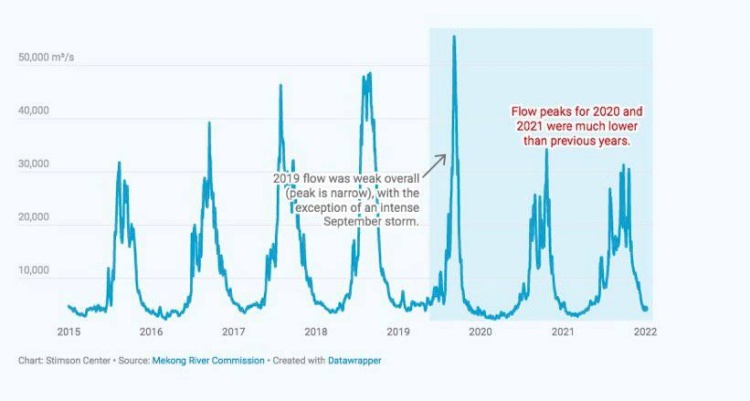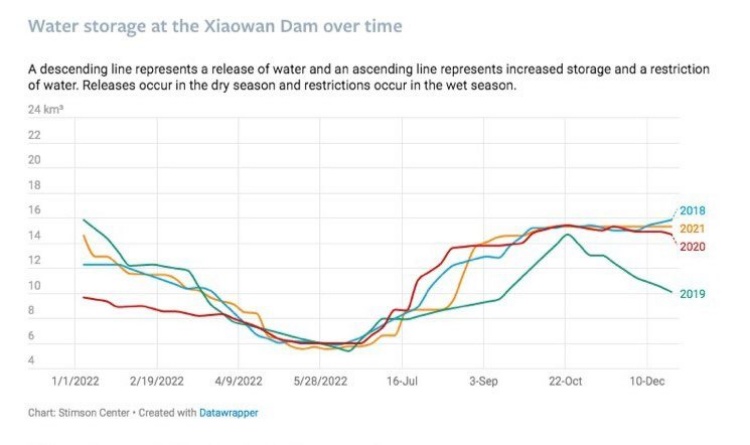Upstream dams severely restricted water flow between 2019 and 2021 during the wet season, exacerbating drought conditions created by the lack of rainfall, a new report says.
“A severe lack of rainfall between 2019 and 2021 was the core driver of drought and low river flows, but dam restrictions during this period significantly impacted wet season flow and exacerbated drought conditions throughout the basin,” says a report released Friday by the Mekong Dam Monitor under Stimson Center.
Stimson Center has operated the Mekong Dam Monitor (MDM) since late 2020.
MDM’s natural flow models show that wet season peaks were considerably lower in 2019 to 2021 than most of the previous years.
When actual gauge data for Chiang Saen in Thailand and Vientiane in Laos are compared to natural flow levels, observed river levels during the wet season across this period are much lower than what natural conditions would provide.
The difference is the result of upstream dams which reduce the Mekong’s wet season pulse. Even though there was a drought, the dam operators also severely restricted the already-limited water flow to fill their reservoirs.
“This greatly compounded the impact of the drought downstream,” the report said.
For example, at Chiang Saen, during the 2019-2021 drought years, actual water flow was lower than natural (undammed) river flow would have been. Water restrictions behind upstream dams significantly reduced wet season flow peaks.
The pattern continued downstream at Vientiane, Laos, and lower flows were also observed far downstream at Stung Treng, Cambodia during the drought years.
 |
|
Lower flows observed downstream at Stung Treng, Cambodia, during the drought years. Graph by Stimson Center |
Enough water in China dams
MDM data shows that large storage dams, including Xiaowan and Nuozhadu in China, generally operated the same way year after year regardless of low flow and drought conditions downstream.
In 2018 and 2020, Xiaowan and Nuozhadu held similar amounts of water (over 20 billion cubic meters), though 2018 was a year with above average rainfall and 2020 was the driest year on record.
Therefore, it reduced the amount of water in lower Mekong.
In 2018, total wet season flow to Stung Treng in Cambodia would have been 5 percent higher without the Xiaowan and Nuozhadu dams. But water flow would have been 9.3 percent higher in 2020 without them because the year was so unusually dry. So China’s dams held the same amount of water back in a drought year as a non-drought year.
Additionally, in 2021, without upstream dam restrictions, the flow at Stung Treng would have been 294 cubic kilometers, 11 percent higher than what was recorded at the MRC gauge. Xiaowan and Nuozhadu accounted for almost twice as much of the missing water compared to 43 other dams tracked in the MDM.
“The pattern (of holding the same water amount) continues despite the 2021 drought,” the report says.
Regarding the impact on downstream countries, the report says that during the wet season, floods drive important processes in the Mekong such as the Tonle Sap reversal, an event which makes the Tonle Sap Lake the world’s largest and most productive inland fishery.
In addition, natural wet season floods drive agricultural production in the Mekong Delta, which provides Vietnam with 20 percent of its annual GDP, half of its rice production, and most of its fruits and aquaculture.
 |
|
Water storage at the Xiaowan Dam over time. Graph by Stimson Center |
- Reduce Hair Loss with PURA D’OR Gold Label Shampoo
- Castor Oil Has Made a “Huge” Difference With Hair and Brow Growth
- Excessive hair loss in men: Signs of illness that cannot be subjective
- Dịch Vụ SEO Website ở Los Angeles, CA: đưa trang web doanh nghiệp bạn lên top Google
- Nails Salon Sierra Madre
 VnExpress News The News Gateway of Vietnam
VnExpress News The News Gateway of Vietnam





